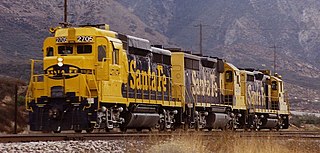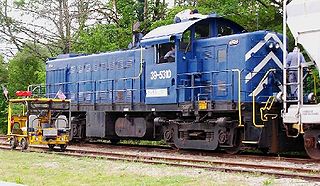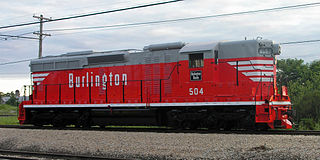
The EMD F40PH is a four-axle 3,000–3,200 hp (2.2–2.4 MW) B-B diesel-electric locomotive built by General Motors Electro-Motive Division in several variants from 1975 to 1992. Intended for use on Amtrak's short-haul passenger routes, it became the backbone of Amtrak's diesel fleet after the failure of the EMD SDP40F. The F40PH also found widespread use on commuter railroads in the United States and with VIA Rail in Canada. Additional F40PH variants were manufactured by Morrison-Knudsen and MotivePower between 1988 and 1998, mostly rebuilt from older locomotives.

The EMD GP30 is a 2,250 hp (1,680 kW) four-axle diesel-electric locomotive built by General Motors Electro-Motive Division of La Grange, Illinois between July 1961 and November 1963. A total of 948 units were built for railroads in the United States and Canada, including 40 cabless B units for the Union Pacific Railroad.

In North American railroad terminology, a cab unit is a railroad locomotive with its own cab and controls.

A road switcher locomotive is a type of railroad locomotive designed to both haul railcars in mainline service and shunt them in railroad yards. Both type and term are North American in origin, although similar types have been used elsewhere.

The EMD SD40-2 is a 3,000-horsepower (2,200 kW) C-C diesel-electric locomotive built by EMD from 1972 to 1989.

The EMD Dash 2 is a line of diesel-electric locomotives introduced by General Motors' Electro-Motive Division (EMD) on January 1, 1972. Designations of these models were those of the former models with "-2" added. They retained the basic specifications of the earlier models in terms of power output and most other features, but introduced a number of improvements to the locomotives' internal systems, specifically the electrical systems and the trucks of the locomotives. These were intended to improve availability, efficiency, and ease of maintenance.

The EMD SD24 was a 2,400 hp (1,800 kW) six-axle (C-C) diesel-electric locomotive built by General Motors' Electro-Motive Division of La Grange, Illinois between July 1958 and March 1963. A total of 224 units were built for customers in the United States, comprising 179 regular, cab-equipped locomotives and 45 cabless B units. The latter were built solely for the Union Pacific Railroad.

The EMD GP7 is a four-axle (B-B) diesel-electric locomotive built by General Motors Electro-Motive Division and General Motors Diesel between October 1949 and May 1954.

The EMD GP38-2 is an American four-axle diesel-electric locomotive built by General Motors, Electro-Motive Division. Part of the EMD Dash 2 line, the GP38-2 was an upgraded version of the earlier GP38. Power is provided by an EMD 645E 16-cylinder engine, which generates 2,000 horsepower.

The EMD GP40 is a 4-axle diesel-electric locomotive built by General Motors' Electro-Motive Division between November 1965 and December 1971. It has an EMD 645E3 16-cylinder engine generating 3,000 hp (2,240 kW).

The passenger locomotives derivatives of the General Motors EMD GP40 diesel-electric locomotive have been, and continue to be, used by multiple passenger railroads in North America. For passenger service, the locomotives required extra components for providing steam or head-end power (HEP) for heating, lighting and electricity in passenger cars. Most of these passenger locomotives were rebuilt from older freight locomotives, while some were built as brand new models.

The EMD GP16 is a series of rebuilt diesel-electric locomotives, a result of a remanufacturing program initiated by the Seaboard Coast Line Railroad (SCL) in an effort to spare the cost of purchasing new motive power in the late 1970s. This involved the rebuilding of their aging fleet of EMD GP7, GP9 and GP18 road switchers. 155 locomotives were rebuilt by the SCL.

The long hood of a hood unit-style diesel locomotive is, as the name implies, the longer of the two hoods on a locomotive, particularly American-type freight locomotives.

The EMD MRS-1 is a type of diesel-electric locomotive built by General Motors Electro-Motive Division for the United States Army Transportation Corps (USATC) in 1952. They were built with multigauge trucks and to a narrow loading gauge for service anywhere in the world in the event of war. Thirteen of the locomotives were built, with serial numbers 15873–15885. At almost $500,000 each in 1952 dollars, more than three times the price of a standard locomotive of the period, these were very expensive locomotives.

The ALCO MRS-1 is a type of diesel-electric locomotive built by the American Locomotive Company for the United States Army Transportation Corps. They were built with multigauge trucks and to a reduced loading gauge for service anywhere in the world in the event of war.

The ALCO RS-3m is a diesel-electric locomotive rebuilt from an ALCO RS-3 road switcher. These 98 locomotives were rebuilt to replace their original ALCO prime mover with the more reliable EMD 567B engine and fan assemblies taken from retired E8s. Many of these rebuilds were performed by the ex NYC DeWitt shop with 56 completed at the ex PRR Juniata shop. The RS3m rebuild program started in 1972 and continued until 1978 under Conrail.

The Dash 7 Series is a line of diesel-electric freight locomotives built by GE Transportation. It replaced the Universal Series in the mid-1970s, and was superseded by the Dash 8 Series in the mid-1980s.

The Dash 8 Series is a line of diesel-electric freight locomotives built by GE Transportation. It replaced the Dash 7 Series in the mid-1980s, and was superseded by the Dash 9 Series for freight usage and the Genesis Series for passenger usage in the mid-1990s.

A B unit, in railroad terminology, is a locomotive unit which does not have a control cab or crew compartment, and must therefore be operated in tandem with another coupled locomotive with a cab. The terms booster unit and cabless are also used. The concept is largely confined to North America and post-Soviet countries. Elsewhere, locomotives without driving cabs are rare.




















